A map of the Levant with Natufian regions across present-day Israel, Palestine, Jordan, and a long arm extending into Lebanon and Syria | |
| Geographical range | Levant, Western Asia |
|---|---|
| Period | Epipaleolithic |
| Dates | 15,000–11,500 BP |
| Type site | Shuqba cave, in Wadi Natuf |
| Major sites | Shuqba cave, Ain Mallaha, Ein Gev, Tell Abu Hureyra |
| Preceded by | Kebaran, Mushabian |
| Followed by | Neolithic: Khiamian, Shepherd Neolithic |
The Natufian culture (/nəˈtuːfiən/[1]) is a Late Epipaleolithic archaeological culture of the Neolithic prehistoric[2] Levant in Western Asia, dating to around 15,000 to 11,500 years ago.[3] The culture was unusual in that it supported a sedentary or semi-sedentary population even before the introduction of agriculture. The Natufian communities may be the ancestors of the builders of the first Neolithic settlements of the region, which may have been the earliest in the world. Some evidence suggests deliberate cultivation of cereals, specifically rye, by the Natufian culture at Tell Abu Hureyra, the site of earliest evidence of agriculture in the world.[2] The world's oldest known evidence of the production of bread-like foodstuff has been found at Shubayqa 1, a 14,400-year-old site in Jordan's northeastern desert, 4,000 years before the emergence of agriculture in Southwest Asia.[4] In addition, the oldest known evidence of possible beer-brewing, dating to approximately 13,000 BP, was found in Raqefet Cave on Mount Carmel, although the beer-related residues may simply be a result of a spontaneous fermentation.[5][6]
Generally, though, Natufians exploited wild cereals and hunted animals, including gazelles.[7] Archaeogenetic analysis has revealed derivation of later (Neolithic to Bronze Age) Levantines primarily from Natufians, besides substantial admixture from Chalcholithic Anatolians.[8]
Dorothy Garrod coined the term Natufian based on her excavations at the Shuqba cave (Wadi an-Natuf) near the town of Shuqba.
Discovery
_1928_Natufian_culture_discovery.jpg.webp)
The Natufian culture was discovered by British archaeologist Dorothy Garrod during her excavations of Shuqba cave in the Judaean Hills, on the West Bank of the Jordan River.[9][10] Prior to the 1930s, the majority of archaeological work taking place in British Palestine was biblical archaeology focused on historic periods, and little was known about the region's prehistory.
In 1928, Garrod was invited by the British School of Archaeology in Jerusalem (BSAJ) to excavate Shuqba cave, where prehistoric stone tools had been discovered by Père Mallon four years earlier. She discovered a layer sandwiched between the Upper Palaeolithic and Bronze Age deposits characterised by the presence of microliths. She identified this with the Mesolithic, a transitional period between the Palaeolithic and the Neolithic which was well-represented in Europe but had not yet been found in the Near East. A year later, when she discovered similar material at el-Wad Terrace, Garrod suggested the name "the Natufian culture", after Wadi an-Natuf that ran close to Shuqba.
Over the next two decades Garrod found Natufian material at several of her pioneering excavations in the Mount Carmel region, including el-Wad, Kebara and Tabun, as did the French archaeologist René Neuville, firmly establishing the Natufian culture in the regional prehistoric chronology. As early as 1931, both Garrod and Neuville drew attention to the presence of stone sickles in Natufian assemblages and the possibility that this represented a very early agriculture.[10]
Dating

| The Mesolithic |
|---|
| ↑ Upper Paleolithic |
| ↓ Neolithic |
| The Paleolithic |
|---|
| ↑ Pliocene (before Homo) |
| ↓ Mesolithic |
Radiocarbon dating places the Natufian culture at an epoch from the terminal Pleistocene to the very beginning of the Holocene, a time period between 12,500 and 9,500 BC.[12]
The period is commonly split into two subperiods: Early Natufian (12,000–10,800 BC) and Late Natufian (10,800–9,500 BC). The Late Natufian most likely occurred in tandem with the Younger Dryas (10,800 to 9,500 BC). The Levant hosts more than a hundred kinds of cereals, fruits, nuts, and other edible parts of plants, and the flora of the Levant during the Natufian period was not the dry, barren, and thorny landscape of today, but rather woodland.[9]
Precursors and associated cultures
The Natufian developed in the same region as the earlier Kebaran culture. It is generally seen as a successor, which evolved out of elements within that preceding culture. There were also other industries in the region, such as the Mushabian culture of the Negev and the Sinai Peninsula, which are sometimes distinguished from the Kebaran or believed to have been involved in the evolution of the Natufian.
More generally there has been discussion of the similarities of these cultures with those found in coastal North Africa. Graeme Barker notes there are: "similarities in the respective archaeological records of the Natufian culture of the Levant and of contemporary foragers in coastal North Africa across the late Pleistocene and early Holocene boundary".[13] According to Isabelle De Groote and Louise Humphrey, Natufians practiced the Iberomaurusian and Capsian custom of sometimes extracting their maxillary central incisors (upper front teeth).[14]

Ofer Bar-Yosef has argued that there are signs of influences coming from North Africa to the Levant, citing the microburin technique and "microlithic forms such as arched backed bladelets and La Mouillah points."[15] But recent research has shown that the presence of arched backed bladelets, La Mouillah points, and the use of the microburin technique was already apparent in the Nebekian industry of the Eastern Levant.[16] And Maher et al. state that, "Many technological nuances that have often been always highlighted as significant during the Natufian were already present during the Early and Middle EP [Epipalaeolithic] and do not, in most cases, represent a radical departure in knowledge, tradition, or behavior."[17]
Authors such as Christopher Ehret have built upon the little evidence available to develop scenarios of intensive usage of plants having built up first in North Africa, as a precursor to the development of true farming in the Fertile Crescent, but such suggestions are considered highly speculative until more North African archaeological evidence can be gathered.[18][19] In fact, Weiss et al. have shown that the earliest known intensive usage of plants was in the Levant 23,000 years ago at the Ohalo II site.[20][21][22]
Anthropologist C. Loring Brace (1993) cross-analysed the craniometric traits of Natufian specimens with those of various ancient and modern groups from the Near East, Africa and Europe. The Late Pleistocene Epipalaeolithic Natufian sample was described as problematic due to its small size (consisting of only three males and one female), as well as the lack of a comparative sample from the Natufians' putative descendants in the Neolithic Near East. Brace observed that the Natufian fossils lay between those of the Niger–Congo-speaking series included and the other samples (Near East, Europe), which he suggested may point to a Sub-Saharan influence in their constitution.[23] Subsequent ancient DNA analysis of Natufian skeletal remains by Lazaridis et al. (2016) found that the specimens instead were a mix of 50% Basal Eurasian ancestral component (see Archaeogenetics) and 50% West-Eurasian Unknown Hunter Gatherer (UHG) population related to European Western Hunter-Gatherers.[24]
According to Bar-Yosef and Belfer-Cohen, "It seems that certain preadaptive traits, developed already by the Kebaran and Geometric Kebaran populations within the Mediterranean park forest, played an important role in the emergence of the new socioeconomic system known as the Natufian culture."[25]
Settlements
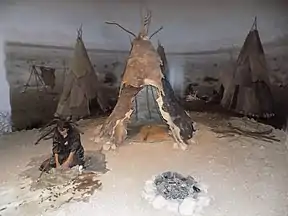
Settlements occur mostly in Israel and Palestine. This could be deemed the core zone of the Natufian culture, but Israel is a place that has been excavated more frequently than other places hence the greater number of sites.[26] During the years more sites have been found outside the core zone of Israel and Palestine stretching into what now is Syria, Lebanon, Jordan, the Sinai Peninsula and the Negev desert.[26] The settlements in the Natufian culture were larger and more permanent than in preceding ones. Some Natufian sites had stone built architecture; Ain Mallaha is an example of round stone structures.[27] Cave sites are also seen frequently during the Natufian culture. El Wad is a Natufian cave site with occupation in the front part of the cave also called the terrace.[28] Some Natufian sites were located in forest/steppe areas and others near inland mountains. The Natufian settlements appear to be the first to exhibit evidence of food storage; not all Natufian sites have storage facilities, but they have been identified at certain sites.[29]

Material culture
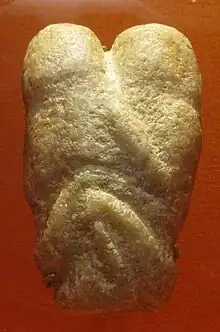
Lithics
The Natufian had a microlithic industry centered on short blades and bladelets. The microburin technique was used. Geometric microliths include lunates, trapezes, and triangles. There are backed blades as well. A special type of retouch (Helwan retouch) is characteristic for the early Natufian. In the late Natufian, the Harif-point, a typical arrowhead made from a regular blade, became common in the Negev. Some scholars use it to define a separate culture, the Harifian.
Sickle blades also appear for the first time in the Natufian lithic industry. The characteristic sickle-gloss shows that they were used to cut the silica-rich stems of cereals, indirectly suggesting the existence of incipient agriculture. Shaft straighteners made of ground stone indicate the practice of archery. There are heavy ground-stone bowl mortars as well.
Art
The Ain Sakhri lovers, a carved stone object held at the British Museum, is the oldest known depiction of a couple having sex. It was found in the Ain Sakhri cave in the Judean desert.[30]
Burials
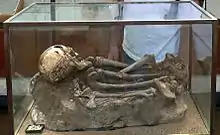
Natufian grave goods are typically made of shell, teeth (of red deer), bones, and stone. There are pendants, bracelets, necklaces, earrings, and belt-ornaments as well.
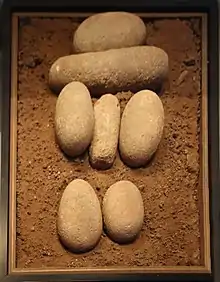
In 2008, the 12,400–12,000 cal BC grave of an apparently significant Natufian female was discovered in a ceremonial pit in the Hilazon Tachtit cave in northern Israel.[31] Media reports referred to this person as a "shaman".[32] The burial contained the remains of at least three aurochs and 86 tortoises, all of which are thought to have been brought to the site during a funeral feast. The body was surrounded by tortoise shells, the pelvis of a leopard, forearm of a boar, a wingtip of a golden eagle, and skull of a beech marten.[33][34]
Long-distance exchange
At Ain Mallaha (in Northern Israel), Anatolian obsidian and shellfish from the Nile valley have been found. The source of malachite beads is still unknown. Epipaleolithic Natufians carried parthenocarpic figs from Africa to the southeastern corner of the Fertile Crescent, c. 10,000 BC.[35]
Other finds
There was a rich bone industry, including harpoons and fish hooks. Stone and bone were worked into pendants and other ornaments. There are a few human figurines made of limestone (El-Wad, Ain Mallaha, Ain Sakhri), but the favorite subject of representative art seems to have been animals. Ostrich-shell containers have been found in the Negev.
In 2018, the world's oldest brewery was found, with the residue of 13,000-year-old beer, in a prehistoric cave near Haifa in Israel when researchers were looking for clues into what plant foods the Natufian people were eating. This is 8,000 years earlier than experts previously thought beer was invented.[36]
A study published in 2019 shows an advanced knowledge of lime plaster production at a Natufian cemetery in Nahal Ein Gev II site in the Upper Jordan Valley dated to 12 thousand (calibrated) years before present [k cal BP]. Production of plaster of this quality was previously thought to have been achieved some 2,000 years later.[37]
Subsistence

The Natufian people lived by hunting and gathering. The preservation of plant remains is poor because of the soil conditions, but at some sites such as Tell Abu Hureyra substantial amounts of plant remains discovered through flotation have been excavated.[38] However wild cereals like legumes, almonds, acorns and pistachios have been collected throughout most of the Levant. Animal bones show that mountain and goitered gazelles (Gazella gazella and Gazella subgutturosa) were the main prey.
Additionally, deer, aurochs and wild boar were hunted in the steppe, as well as onagers and caprids (ibex). Waterfowl and freshwater fish formed part of the diet in the Jordan river valley. Animal bones from Salibiya I (12,300 – 10,800 cal BP) have been interpreted as evidence for communal hunts with nets, however, the radiocarbon dates are far too old compared to the cultural remains of this settlement, indicating contamination of the samples.[39]
Development of agriculture
A pita-like bread has been found from 12,500 BC attributed to Natufians. This bread is made of wild cereal seeds and papyrus cousin tubers, ground into flour.[40]
According to one theory,[32] it was a sudden change in climate, the Younger Dryas event (c. 10,800 to 9500 BC), which inspired the development of agriculture. The Younger Dryas was a 1,000-year-long interruption in the higher temperatures prevailing since the Last Glacial Maximum, which produced a sudden drought in the Levant. This would have endangered the wild cereals, which could no longer compete with dryland scrub, but upon which the population had become dependent to sustain a relatively large sedentary population. By artificially clearing scrub and planting seeds obtained from elsewhere, they began to practice agriculture. However, this theory of the origin of agriculture is controversial in the scientific community.[41]
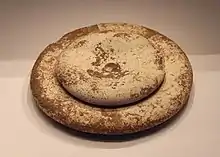 Grinding tool from Gilgal, Natufian culture, 12,500–9500 BC
Grinding tool from Gilgal, Natufian culture, 12,500–9500 BC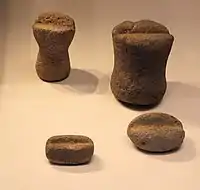 Basalt sharpening stones, Eynan and Nahal Oren, Natufian Culture, 12,500–9500 BC
Basalt sharpening stones, Eynan and Nahal Oren, Natufian Culture, 12,500–9500 BC Bovine-rib dagger, HaYonim Cave, Natufian Culture, 12,500–9500 BC
Bovine-rib dagger, HaYonim Cave, Natufian Culture, 12,500–9500 BC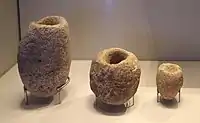 Stone mortars from Eynan, Natufian period, 12,500–9500 BC
Stone mortars from Eynan, Natufian period, 12,500–9500 BC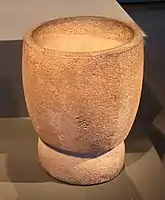 Stone mortar from Eynan, Natufian period, 12,500–9500 BC
Stone mortar from Eynan, Natufian period, 12,500–9500 BC Limestone and basalt mortars, Eynan, Early Natufian, c. 12,000 BC
Limestone and basalt mortars, Eynan, Early Natufian, c. 12,000 BC
Domesticated dog
At the Natufian site of Ain Mallaha in Israel, dated to 12,000 BC, the remains of an elderly human and a four-to-five-month-old puppy were found buried together.[42] At another Natufian site at the cave of Hayonim, humans were found buried with two canids.[42]
Archaeogenetics

Ancient DNA analysis has confirmed the genetic relationship between Natufians and other ancient and modern Middle Easterners and the broader West Eurasian meta-population (i.e. Europeans and South-Central Asians). The Natufian population displays also ancestral ties to Paleolithic Taforalt samples, the makers of the Epipaleolithic Iberomaurusian culture of the Maghreb,[44] the Pre-Pottery Neolithic culture of the Levant,[44] the Early Neolithic Ifri N'Amr Ou Moussa culture of the Maghreb,[45] the Late Neolithic Kelif el Boroud culture of the Maghreb,[45][46] with samples associated with these early cultures all sharing a common genomic component dubbed the "Natufian component", which diverged from other West Eurasian lineages ~26,000 years ago, and is most closely linked to the Arabian lineage.[45][47][48]
Individuals associated with the Natufian culture have been found to cluster with other West Eurasian populations, but also have substantial higher ancestry that can be traced back to the hypothetical "Basal Eurasian" lineage, which contributed in varying degrees to all West Eurasian lineages, except the Ancient North Eurasians, and peaks among modern Gulf Arabs.[49][50] The Natufians were already differentiated from other West Eurasian lineages, such as the Anatolian farmers north of the Levant, that contributed to the peopling of Europe in significant amounts, and who had some Western Hunter Gatherer-like (WHG) inferred ancestry, in contrast to Natufians who lacked this component (similar to Neolithic Iranian farmers from the Zagros mountains).[49] This might suggest that different strains of West Eurasians contributed to Natufians and Zagros farmers,[51][52][53] as both Natufians and Zagros farmers descended from different populations of local hunter gatherers. Contact between Natufians, other Neolithic Levantines, Caucasus Hunter Gatherers (CHG), Anatolian and Iranian farmers is believed to have decreased genetic variability among later populations in the Middle East. Migrations from the Near-East also occurred towards Africa, and the West Eurasian geneflow into the Horn of Africa is best represented by the Levant Neolithic, and may be associated with the spread of Afroasiatic languages. The scientists suggest that the Levantine early farmers may have spread southward into East Africa, bringing along the associated ancestral components.[24][54][55]
According to ancient DNA analyses conducted in 2016 by Iosif Lazaridis et al. and discussed in two articles "The Genetic Structure of the World's First Farmers" (June 2016) and "Genomic Insights into the Origin of Farming in the Ancient Near East (July 2016)[56][57] on Natufian skeletal remains in the Raqefet Cave from present-day northern Israel, the remains of 5 Natufians carried the following paternal haplgroups:
Y-DNA
- E1b1b1b2 (xE1b1b1b2a, E1b1b1b2b) - meaning an unspecified branch of E1b1b1b2
- E1b1 (xE1b1a1, E1b1b1b1) - i.e. a branch of E1b1 that is neither E1b1a1 nor E1b1b1b1.
- E1b1b1 - originally classified as CT but further defined as E1b1b1 by Martiniano et al. 2020.[58]
Daniel Shriner (2018) reported the following maternal haplogroups recovered from three of the same six males at the Raqefet Cave:
Mitochondrial DNA
- J2a2
- J2a2
- N1b
using modern populations as a reference, Shriner et al. also showed indicated Natufians carried 61.2% Arabian, 21.2% Northern African, 10.9% Western Asian, and a small amount of Eastern African ancestry at 6.8% which is associated with the modern Omotic-speaking groups of southern Ethiopia. The study also suggested that this component may be the source of Haplogroup E-M96 (particularly Y-haplogroup E-M215, also known as "E1b1b") among Natufians.[46]
Loosedrecht et al. (2018) argues that the Natufians had contributed genetically to the Iberomaurusian peoples of Paleolithic and Mesolithic northwest Africa, with the Iberomaurusians' other ancestral component being a unique one of sub-Saharan Africa origin (having both West African-like and Hadza-like affinities).[47] The Sub-Saharan African DNA in Taforalt individuals has the closest affinity, most of all, to that of modern West Africans (e.g., Yoruba, or Mende).[47] In addition to having similarity with the remnant of a more basal Sub-Saharan African lineage (e.g., a basal West African lineage shared between Yoruba and Mende peoples), the Sub-Saharan African DNA in the Taforalt individuals of the Iberomaurusian culture may be best represented by modern West Africans.[59]
Iosif Lazaridis et al. (2018), as summarized by Rosa Fregel (2021), contested the conclusion of Loosdrecht (2018) and argued instead that the Iberomaurusian population of Upper Paleolithic North Africa, represented by the Taforalt sample, can be better modeled as an admixture between a Dzudzuana-like [West-Eurasian] component and an "Ancient North African" component, "that may represent an even earlier split than the Basal Eurasians." Iosif Lazaridis et al. (2018) also argued that an Iberomaurusian/Taforalt-like population contributed to the genetic composition of Natufians "and not the other way around", and that this Iberomaurusian/Taforalt lineage also contributed around 13% ancestry to modern West Africans "rather than Taforalt having ancestry from an unknown Sub-Saharan African source". Fregel (2021) summarized: "More evidence will be needed to determine the specific origin of the North African Upper Paleolithic populations."[60][61]
Ferreira et al. in 2021 found that ancient Natufians cluster with modern Saudi Arabians and Yemenis.[62]
Language
Alexander Militarev, Vitaly Shevoroshkin and others have linked the Natufian culture to the proto-Afroasiatic language,[63][64] which they in turn believe has a Levantine origin. Some scholars, for example Christopher Ehret, Roger Blench and others, contend that the Afroasiatic Urheimat is to be found in North Africa or Northeast Africa, probably in the area of Egypt, the Sahara, Horn of Africa or Sudan.[65][66][67][68][69] Within this group, Ehret, who like Militarev believes Afroasiatic may already have been in existence in the Natufian period, would associate Natufians only with the Near Eastern Proto-Semitic branch of Afroasiatic.
Sites
The Natufian culture has been documented at dozens of sites. Around 90 have been excavated, including:[70]
- Aammiq 2
- Tell Abu Hureyra
- Abu Salem
- Abu Usba
- Ain Choaab
- Ain Mallaha (Eynan)
- Ain Rahub
- Ain Sakhri
- Ala Safat
- Antelias Cave
- Azraq 18 (Ain Saratan)
- Baaz
- Bawwab al Ghazal
- Beidha
- Dederiyeh
- Dibsi Faraj
- El Khiam
- El Kowm I
- El Wad
- Erq el Ahmar
- Fazael IV & VI
- Gilgal II
- Givat Hayil I
- Har Harif K7
- Hatoula
- Hayonim Cave and Hayonim Terrace
- Hilazon Tachtit
- Hof Shahaf
- Huzuq Musa
- Iraq ed Dubb
- Iraq el Barud
- Iraq ez Zigan
- J202
- J203
- J406a
- J614
- Jayroud 1–3 & 9
- Jebel Saaidé II
- Jeftelik
- Jericho
- Kaus Kozah
- Kebara
- Kefar Vitkin 3
- Khallat Anaza (BDS 1407)
- Khirbat Janba
- Kosak Shamali
- Maaleh Ramon East
- Maaleh Ramon West
- Moghr el Ahwal
- Mureybet
- Mushabi IV & XIX
- Nachcharini Cave
- Nahal Ein Gev II
- Nahal Hadera I and Nahal Hadera IV (Hefsibah)
- Nahal Oren
- Nahal Sekher 23
- Nahal Sekher VI
- Nahr el Homr 2
- Qarassa 3
- Ramat Harif (G8)
- Raqefet Cave
- Rosh Horesha
- Rosh Zin
- Sabra 1
- Saflulim
- Salibiya 1
- Salibiya 9
- Sands of Beirut
- Shluhat Harif
- Shubayqa 1
- Shubayqa 6
- Shukhbah Cave
- Shunera VI
- Shunera VII
- Tabaqa (WHS 895)[71]
- Taibé
- TBAS 102
- TBAS 212
- Tor at Tariq (WHS 1065)
- Tugra I
- Upper Besor 6
- Wadi Hammeh 27
- Wadi Jilat 22
- Wadi Judayid (J2)
- Wadi Mataha
- Yabrud 3
- Yutil al Hasa (WHS 784)
See also
References
- ↑ "Natufian". Oxford English Dictionary (Online ed.). Oxford University Press. (Subscription or participating institution membership required.)
- 1 2 Moore, Andrew M. T.; Hillman, Gordon C.; Legge, Anthony J. (2000), Village on the Euphrates: From Foraging to Farming at Abu Hureyra, Oxford: Oxford University Press, ISBN 978-0-19-510806-4
- ↑ Grosman, Leore (2013). "The Natufian Chronological Scheme – New Insights and their Implications". In Bar-Yosef, Ofer; Valla, François R. (eds.). Natufian Foragers in the Levant: Terminal Pleistocene Social Changes in Western Asia (1 ed.). New York: Berghahn Books. pp. 622–627. doi:10.2307/j.ctv8bt33h. ISBN 978-1-879621-45-9. JSTOR j.ctv8bt33h – via JSTOR.
- ↑ Arranz-Otaegui, Amaia; Gonzalez Carretero, Lara; Ramsey, Monica N.; Fuller, Dorian Q.; Richter, Tobias (2018-07-31). "Archaeobotanical evidence reveals the origins of bread 14,400 years ago in northeastern Jordan". Proceedings of the National Academy of Sciences. 115 (31): 7925–7930. Bibcode:2018PNAS..115.7925A. doi:10.1073/pnas.1801071115. ISSN 0027-8424. PMC 6077754. PMID 30012614.
- ↑ Liu, Li; Wang, Jiajing; Rosenberg, Danny; Zhao, Hao; Lengyel, György; Nadel, Dani (2018-10-01). "Fermented beverage and food storage in 13,000 y-old stone mortars at Raqefet Cave, Israel: Investigating Natufian ritual feasting". Journal of Archaeological Science: Reports. 21: 783–793. doi:10.1016/j.jasrep.2018.08.008. ISSN 2352-409X. S2CID 165595175.
- ↑ Eitam, David (2019). "'Yo-ho-ho, and a bottle of [beer]!' (R.L. Stevenson) no beer but rather cereal-Food. Commentary: Liu et al. 2018". Journal of Archaeological Science: Reports. 28: 101913. doi:10.1016/j.jasrep.2019.101913. S2CID 198454176.
- ↑ Kottak, Conrad P. (2005), Window on Humanity: A Concise Introduction to Anthropology, Boston: McGraw-Hill, pp. 155–156, ISBN 978-0-07-289028-0
- ↑ Lazaridis, Iosif; Nadel, Dani; Rollefson, Gary; Merrett, Deborah C.; Rohland, Nadin; Mallick, Swapan; Fernandes, Daniel; Novak, Mario; Gamarra, Beatriz; Sirak, Kendra; Connell, Sarah; Stewardson, Kristin; Harney, Eadaoin; Fu, Qiaomei; Gonzalez-Fortes, Gloria; Jones, Eppie R.; Roodenberg, Songül Alpaslan; Lengyel, György; Bocquentin, Fanny; Gasparian, Boris; Monge, Janet M.; Gregg, Michael; Eshed, Vered; Mizrahi, Ahuva-Sivan; Meiklejohn, Christopher; Gerritsen, Fokke; Bejenaru, Luminita; Blüher, Matthias; Campbell, Archie; Cavalleri, Gianpiero; Comas, David; Froguel, Philippe; Gilbert, Edmund; Kerr, Shona M.; Kovacs, Peter; Krause, Johannes; McGettigan, Darren; Merrigan, Michael; Merriwether, D. Andrew; O'Reilly, Seamus; Richards, Martin B.; Semino, Ornella; Shamoon-Pour, Michel; Stefanescu, Gheorghe; Stumvoll, Michael; Tönjes, Anke; Torroni, Antonio; Wilson, James F.; Yengo, Loic; Hovhannisyan, Nelli A.; Patterson, Nick; Pinhasi, Ron; Reich, David (2016). "Genomic insights into the origin of farming in the ancient Near East" (PDF). Nature. 536 (7617): 419–424. Bibcode:2016Natur.536..419L. doi:10.1038/nature19310. PMC 5003663. PMID 27459054. Fig. 4. "Our data document continuity across the transition between hunter– gatherers and farmers, separately in the southern Levant and in the southern Caucasus–Iran highlands. The qualitative evidence for this is that PCA, ADMIXTURE, and outgroup f3 analysis cluster Levantine hunter–gatherers (Natufians) with Levantine farmers, and Iranian and CHG with Iranian farmers (Fig. 1b and Extended Data Figs 1, 3). We confirm this in the Levant by showing that its early farmers share significantly more alleles with Natufians than with the early farmers of Iran" Epipaleolithic Natufians were substantially derived from the Basal Eurasian lineage. "We used qpAdm (ref. 7) to estimate Basal Eurasian ancestry in each Test population. We obtained the highest estimates in the earliest populations from both Iran (66±13% in the likely Mesolithic sample, 48±6% in Neolithic samples), and the Levant (44±8% in Epipalaeolithic Natufians) (Fig. 2), showing that Basal Eurasian ancestry was widespread across the ancient Near East. [...] The idea of Natufians as a vector for the movement of Basal Eurasian ancestry into the Near East is also not supported by our data, as the Basal Eurasian ancestry in the Natufians (44±8%) is consistent with stemming from the same population as that in the Neolithic and Mesolithic populations of Iran, and is not greater than in those populations (Supplementary Information, section 4). Further insight into the origins and legacy of the Natufians could come from comparison to Natufians from additional sites, and to ancient DNA from North Africa."
- 1 2 Bar-Yosef, Ofer (1998), "The Natufian Culture in the Levant, Threshold to the Origins of Agriculture" (PDF), Evolutionary Anthropology, 6 (5): 159–177, doi:10.1002/(SICI)1520-6505(1998)6:5<159::AID-EVAN4>3.0.CO;2-7, S2CID 35814375
- 1 2 Boyd, Brian (1999). "'Twisting the kaleidoscope': Dorothy Garrod and the 'Natufian Culture'". In Davies, William; Charles, Ruth (eds.). Dorothy Garrod and the progress of the Palaeolithic. Oxford: Oxbow. pp. 209–223. ISBN 978-1-78570-519-9.
- ↑ Zalloua, Pierre A.; Matisoo-Smith, Elizabeth (6 January 2017). "Mapping Post-Glacial expansions: The Peopling of Southwest Asia". Scientific Reports. 7: 40338. Bibcode:2017NatSR...740338P. doi:10.1038/srep40338. ISSN 2045-2322. PMC 5216412. PMID 28059138.
- ↑ Munro, Natalie D. (2003). "Small game, the Younger Dryas, and the transition to agriculture in the southern Levant" (PDF). Mitteilungen der Gesellschaft für Urgeschichte. 12: 47–71. ISSN 1611-7948. Wikidata Q107520328.
- ↑ Barker G (2002) Transitions to farming and pastoralism in North Africa, in Bellwood P, Renfrew C (2002), Examining the Farming/Language Dispersal Hypothesis, pp 151–161.
- ↑ De Groote, Isabelle; Humphrey, Louise T. (2016-08-22). "Characterizing evulsion in the Later Stone Age Maghreb: Age, sex and effects on mastication" (PDF). Quaternary International. 413: 50–61. Bibcode:2016QuInt.413...50D. doi:10.1016/j.quaint.2015.08.082. ISSN 1040-6182. S2CID 130343302.
- ↑ Bar-Yosef O (1987) Pleistocene connections between Africa and SouthWest Asia: an archaeological perspective. The African Archaeological Review; Chapter 5, pg 29–38
- ↑ Richter, Tobias (2011). "Interaction before Agriculture: Exchanging Material and Sharing Knowledge in the Final Pleistocene Levant" (PDF). Cambridge Archaeological Journal. 21: 95–114. doi:10.1017/S0959774311000060. S2CID 162887983.
- ↑ Maher, Tobias; Richter, Lisa A.; Stock, Jay T. (2012). "The Pre-Natufian Epipaleolithic: Long-Term Behavioral Trends in the Levant". Evolutionary Anthropology. 21 (2): 69–81. doi:10.1002/evan.21307. PMID 22499441. S2CID 32252766.
- ↑ Ehret (2002) The Civilizations of Africa: A History to 1800. Charlottesville: University Press of Virginia
- ↑ Bellwood P (2005) Blackwell, Oxford. Page 97
- ↑ Weiss, E; Kislev, ME; Simchoni, O; Nadel, D; Tschauner, H (2008). "Plant-food preparation area on an Upper Paleolithic brush hut floor at Ohalo II, Israel". Journal of Archaeological Science. 35 (8): 2400–2414. Bibcode:2008JArSc..35.2400W. doi:10.1016/j.jas.2008.03.012.
- ↑ Nadel, D; Piperno, DR; Holst, I; Snir, A; Weiss, E (2012). "New evidence for the processing of wild cereal grains at Ohalo II, a 23 000-year-old campsite on the shore of the Sea of Galilee, Israel". Antiquity. 86 (334): 990–1003. doi:10.1017/s0003598x00048201. S2CID 162019976.
- ↑ Weiss, Ehud; Wetterstrom, Wilma; Nadel, Dani; Bar-Yosef, Ofer (2004-06-29). "The broad spectrum revisited: Evidence from plant remains". Proceedings of the National Academy of Sciences. 101 (26): 9551–9555. Bibcode:2004PNAS..101.9551W. doi:10.1073/pnas.0402362101. ISSN 0027-8424. PMC 470712. PMID 15210984.
- ↑ Brace, C. Loring; et al. (2006). "The questionable contribution of the Neolithic and the Bronze Age to European craniofacial form". PNAS. 103 (1): 242–247. Bibcode:2006PNAS..103..242B. doi:10.1073/pnas.0509801102. PMC 1325007. PMID 16371462.
The Natufian sample from Israel is also problematic because it is so small, being constituted of three males and one female from the Late Pleistocene Epipalaeolithic (34) of Israel, and there was no usable Neolithic sample for the Near East... the small Natufian sample falls between the Niger-Congo group and the other samples used. Fig. 2 shows the plot produced by the first two canonical variates, but the same thing happens when canonical variates 1 and 3 (not shown here) are used. This placement suggests that there may have been a Sub-Saharan African element in the make-up of the Natufians (the putative ancestors of the subsequent Neolithic)
- 1 2 Lazaridis, Iosif; et al. (17 June 2016). "The genetic structure of the world's first farmers". bioRxiv 10.1101/059311. – Table S6.1 – Y-chromosome haplogroups
- ↑ Bar-Yosef, Ofer; Belfer-Cohen, Anna (1989). "The Origins of Sedentism and Farming Communities in the Levant". Journal of World Prehistory. 3 (4): 447–498. doi:10.1007/bf00975111. S2CID 162966796.
- 1 2 Belfer-Cohen, Anna (1991). "The Natufian in the Levant". Annual Review of Anthropology. 20: 167–186. doi:10.1146/annurev.an.20.100191.001123. ISSN 0084-6570. JSTOR 2155798.
- ↑ Byrd, Brian F. (1989-06-01). "The Natufian: Settlement variability and economic adaptations in the Levant at the end of the Pleistocene". Journal of World Prehistory. 3 (2): 159–197. doi:10.1007/BF00975760. ISSN 1573-7802. S2CID 162302031.
- ↑ Weinstein-Evron, Mina; Yeshurun, Reuven; Ashkenazy, Hila; Chasan, Rivka; Rosenberg, Danny; Bachrach, Noga; Boaretto, Elisabetta; Caracuta, Valentina; Kaufman, Daniel; וינשטיין-עברון, מינה; ישורון, ראובן; אשכנזי, הילה; חזן, רבקה; רוזנברג, דני; בכרך, נגה (2018). "After 80 Years – Deeper in the Natufian Layers of el-Wad Terrace, Mount Carmel, Israel / לאחר שמונים שנה: סיכום עונות החפירה 2012-2007 בשכבות הנאטופיות של טרסת מערת הנחל (אל-ואד), הכרמל, ישראל". Mitekufat Haeven: Journal of the Israel Prehistoric Society / מתקופת האבן. 48: 5–61. ISSN 0334-3839. JSTOR 26579622.
- ↑ Boyd, Brian (2006-06-01). "On 'sedentism' in the Later Epipalaeolithic (Natufian) Levant". World Archaeology. 38 (2): 164–178. doi:10.1080/00438240600688398. ISSN 0043-8243. S2CID 143734829.
- ↑ "BBC - A History of the World - Object: Ain Sakhri lovers figurine". www.bbc.co.uk.
- ↑ Grosman, L.; Munro, N. D.; Belfer-Cohen, A. (2008). "A 12,000-year-old Shaman burial from the southern Levant (Israel)". Proceedings of the National Academy of Sciences. 105 (46): 17665–17669. Bibcode:2008PNAS..10517665G. doi:10.1073/pnas.0806030105. ISSN 0027-8424. PMC 2584673. PMID 18981412.
- 1 2 "Oldest Shaman Grave Found". National Geographic 04-Nov-2008
- ↑ "Hebrew U. unearths 12,000-year-old skeleton of 'petite' Natufian priestess". By Bradley Burston. Haaretz, 05-Nov-2008
- ↑ Hogenboom, Melissa (24 May 2016), Secrets of the world's oldest funeral feast, earth, BBC, retrieved 24 May 2016
- ↑ Kislev, ME; Hartmann, A; Bar-Yosef, O (2006). "Early domesticated fig in the Jordan Valley". Science. 312 (5778): 1372–1374. Bibcode:2006Sci...312.1372K. doi:10.1126/science.1125910. PMID 16741119. S2CID 42150441.
- ↑ "'World's oldest brewery' found in a cave in Israel, say researchers". BBC. 15 September 2018.
- ↑ Friesem, David E.; Abadi, Itay; Shaham, Dana; Grosman, Leore (30 September 2019). "'Lime plaster covering burials 12,000 years ago presents a technological leap forward at the end of the Palaeolithic". Cambridge University Press. 1: e9. doi:10.1017/ehs.2019.9. PMC 10427327. PMID 37588409.
- ↑ Bar-Yosef, Offer. "The Natufian Culture in the Levant, Threshold to the Origins of Agriculture" (PDF). Evolutionary Anthropology.
- ↑ Mithen, Steven (2006). After the Ice: A Global Human History, 20,000–5000 BC. Harvard University Press. ISBN 978-0-674-01999-7.
- ↑ "World's oldest bread found at prehistoric site in Jordan", The Jerusalem Post, 2018, retrieved 16 July 2018
- ↑ Balter, Michael (2010), "Archaeology: The Tangled Roots of Agriculture", Science, 327 (5964): 404–406, doi:10.1126/science.327.5964.404, PMID 20093449
- 1 2 Clutton-Brock, Juliet (1995), "Origins of the dog: domestication and early history", in Serpell, James (ed.), The domestic dog: its evolution, behaviour and interactions with people, Cambridge: Cambridge University Press, ISBN 978-0-521-41529-3
- ↑ Feldman, Michal; Fernández-Domínguez, Eva; Reynolds, Luke; Baird, Douglas; Pearson, Jessica; Hershkovitz, Israel; May, Hila; Goring-Morris, Nigel; Benz, Marion; Gresky, Julia; Bianco, Raffaela A.; Fairbairn, Andrew; Mustafaoğlu, Gökhan; Stockhammer, Philipp W.; Posth, Cosimo (2019-03-19). "Late Pleistocene human genome suggests a local origin for the first farmers of central Anatolia". Nature Communications. 10 (1): 1218. Bibcode:2019NatCo..10.1218F. doi:10.1038/s41467-019-09209-7. ISSN 2041-1723. PMC 6425003. PMID 30890703. S2CID 256633173.
- 1 2 van de Loosdrecht; et al. (2018-03-15). "Pleistocene North African genomes link Near Eastern and sub-Saharan African human populations". Science. 360 (6388): 548–552. Bibcode:2018Sci...360..548V. doi:10.1126/science.aar8380. ISSN 0036-8075. PMID 29545507.
- 1 2 3 Fregel; et al. (2018). "Ancient genomes from North Africa evidence prehistoric migrations to the Maghreb from both the Levant and Europe" (PDF). Proceedings of the National Academy of Sciences of the United States of America. 115 (26): 6774–6779. Bibcode:2018PNAS..115.6774F. bioRxiv 10.1101/191569. doi:10.1073/pnas.1800851115. PMC 6042094. PMID 29895688. S2CID 214727201.
- 1 2 Shriner D (2018). "Re-analysis of Whole Genome Sequence Data From 279 Ancient Eurasians Reveals Substantial Ancestral Heterogeneity". Frontiers in Genetics. 9: 268. doi:10.3389/fgene.2018.00268. PMC 6062619. PMID 30079081.
- 1 2 3 van de Loosdrecht, Marieke; Bouzouggar, Abdeljalil; Humphrey, Louise; Posth, Cosimo; Barton, Nick; Aximu-Petri, Ayinuer; Nickel, Birgit; Nagel, Sarah; Talbi, El Hassan; El Hajraoui, Mohammed Abdeljalil; Amzazi, Saaïd; Hublin, Jean-Jacques; Pääbo, Svante; Schiffels, Stephan; Meyer, Matthias (2018-05-04). "Pleistocene North African genomes link Near Eastern and sub-Saharan African human populations". Science. 360 (6388): 548–552. Bibcode:2018Sci...360..548V. doi:10.1126/science.aar8380. ISSN 0036-8075. PMID 29545507. S2CID 206666517.
- ↑ Lazaridis, Iosif; Nadel, Dani; Rollefson, Gary; Merrett, Deborah C.; Rohland, Nadin; Mallick, Swapan; Fernandes, Daniel; Novak, Mario; Gamarra, Beatriz; Sirak, Kendra; Connell, Sarah; Stewardson, Kristin; Harney, Eadaoin; Fu, Qiaomei; Gonzalez-Fortes, Gloria (2016-08-25). "Genomic insights into the origin of farming in the ancient Near East". Nature. 536 (7617): 419–424. Bibcode:2016Natur.536..419L. doi:10.1038/nature19310. ISSN 0028-0836. PMC 5003663. PMID 27459054.
- 1 2 Lazaridis, I; Nadel, D; Rollefson, G; Merrett, DC; Rohland, N; Mallick, S; Fernandes, D; Novak, M; Gamarra, B (2016). "Genomic insights into the origin of farming in the ancient Near East". Nature. 536 (7617): 419–424. Bibcode:2016Natur.536..419L. doi:10.1038/nature19310. PMC 5003663. PMID 27459054.
- ↑ Almarri, Mohamed A.; Haber, Marc; Lootah, Reem A.; Hallast, Pille; Turki, Saeed Al; Martin, Hilary C.; Xue, Yali; Tyler-Smith, Chris (2021-09-02). "The genomic history of the Middle East". Cell. 184 (18): 4612–4625.e14. doi:10.1016/j.cell.2021.07.013. ISSN 0092-8674. PMC 8445022. PMID 34352227.
- ↑ Broushaki, F; Thomas, MG; Link, V; López, S; van Dorp, L; Kirsanow, K; Hofmanová, Z; Diekmann, Y; Cassidy, LM; Díez-del-Molino, D; Kousathanas, A; Sell, C; Robson, HK; Martiniano, R; Blöcher, J; Scheu, A; Kreutzer, S; Bollongino, R; Bobo, D; Davoudi, H; Munoz, O; Currat, M; Abdi, K; Biglari, F; Craig, OE; Bradley, DG; Shennan, S; Veeramah, KR; Mashkour, M; Wegmann, D; Hellenthal, G; Burger, J (2016). "Early Neolithic genomes from the eastern Fertile Crescent". Science. 353 (6298): 499–503. Bibcode:2016Sci...353..499B. doi:10.1126/science.aaf7943. PMC 5113750. PMID 27417496.
- ↑ Gallego-Llorente, M; Connell, S; Jones, ER; Merrett, DC; Jeon, Y; Eriksson, A; Siska, V; Gamba, C; Meiklejohn, C; Beyer, R; Jeon, S; Cho, YS; Hofreiter, M; Bhak, J; Manica, A; Pinhasi, R (2016). "The genetics of an early Neolithic pastoralist from the Zagros, Iran". Sci Rep. 6: 31326. Bibcode:2016NatSR...631326G. doi:10.1038/srep31326. PMC 4977546. PMID 27502179.
- ↑ Fernández, E; Pérez-Pérez, A; Gamba, C; Prats, E; Cuesta, P; Anfruns, J; Molist, M; Arroyo-Pardo, E; Turbón, D (2014). "Ancient DNA analysis of 8000 B.C. near eastern farmers supports an early neolithic pioneer maritime colonization of Mainland Europe through Cyprus and the Aegean Islands". PLOS Genet. 10 (6): e1004401. doi:10.1371/journal.pgen.1004401. PMC 4046922. PMID 24901650.
- ↑ Lazaridis, Iosif; et al. (2016). "The genetic structure of the world's first farmers". Nature. 536 (7617): 419–424. Bibcode:2016Natur.536..419L. bioRxiv 10.1101/059311. doi:10.1038/nature19310. PMC 5003663. PMID 27459054. S2CID 89467381.
However, no affinity of Natufians to sub-Saharan Africans is evident in our genome-wide analysis, as present-day sub-Saharan Africans do not share more alleles with Natufians than with other ancient Eurasians (Extended Data Table 1).
- ↑ Lazaridis, Iosif; Nadel, Dani; Rollefson, Gary; Merrett, Deborah C.; Rohland, Nadin; Mallick, Swapan; Fernandes, Daniel; Novak, Mario; Gamarra, Beatriz; Sirak, Kendra; Connell, Sarah; Stewardson, Kristin; Harney, Eadaoin; Fu, Qiaomei; Gonzalez-Fortes, Gloria (2016-06-16). "The genetic structure of the world's first farmers". bioRxiv: 059311. doi:10.1101/059311. S2CID 89467381.
- ↑ Lazaridis, Iosif; et al. (17 June 2016). "The genetic structure of the world's first farmers". bioRxiv 10.1101/059311. – Table S6.1 – Y-chromosome haplogroups
- ↑ Lazaridis, Iosif et al. Genomic insights into the origin of farming in the ancient Near East, Nature 536, 419–424, 2016. Supplementary Table 1.
- ↑ Martiniano, Rui; Sanctis, Bianca De; Hallast, Pille; Durbin, Richard (2020-12-20). "Placing ancient DNA sequences into reference phylogenies". Molecular Biology and Evolution. 39 (2): 2020.12.19.423614. bioRxiv 10.1101/2020.12.19.423614. doi:10.1093/molbev/msac017. PMC 8857924. PMID 35084493. S2CID 229549849.
- ↑ Jeong, Choongwon (2020). "Current Trends in Ancient DNA Study: Beyond Human Migration in and Around Europe". The Handbook of Mummy Studies. The Handbook of Mummy Studies. pp. 1–16. doi:10.1007/978-981-15-1614-6_10-1. ISBN 978-981-15-1614-6. S2CID 226555687.
{{cite book}}:|website=ignored (help) - ↑ Fregel, Rosa (2021-11-17). Paleogenomics of the Neolithic Transition in North Africa. Brill. ISBN 978-90-04-50022-8.
However, a preprint from Lazaridis et al. (2018) has contested this conclusion based on new evidence from Paleolithic samples from the Dzudzuana site in Georgia (25,000 years BCE). When these samples are considered in the analysis, Taforalt can be better modeled as a mixture of a Dzudzuana component and a sub-Saharan African component. They also argue that it is the Taforalt people who contributed to the genetic composition of Natufians and not the other way around. More evidence will be needed to determine the specific origin of the North African Upper Paleolithic populations, but the presence of an ancestral U6 lineage in the Dzudzuana people is consistent with this population being related to the back migration to Africa.
- ↑ Lazaridis, Iosif; Belfer-Cohen, Anna; Mallick, Swapan; Patterson, Nick; Cheronet, Olivia; Rohland, Nadin; Bar-Oz, Guy; Bar-Yosef, Ofer; Jakeli, Nino; Kvavadze, Eliso; Lordkipanidze, David; Matzkevich, Zinovi; Meshveliani, Tengiz; Culleton, Brendan J.; Kennett, Douglas J. (2018-09-21). "Paleolithic DNA from the Caucasus reveals core of West Eurasian ancestry". doi:10.1101/423079.
Moreover, our model predicts that West Africans (represented by Yoruba) had 12.5±1.1% ancestry from a Taforalt related group rather than Taforalt having ancestry from an unknown Sub-Saharan African source; this may have mediated the limited Neanderthal admixture present in West Africans. An advantage of our model is that it allows for a local North African component in the ancestry of Taforalt, rather than deriving them exclusively from Levantine and Sub-Saharan sources. ... and Taforalt, can all be modeled as a mixture of Dzudzuana and additional 'Deep' ancestry that may represent an even earlier split than the Basal Eurasians.
{{cite journal}}: Cite journal requires|journal=(help) - ↑ Ferreira, Joana C; Alshamali, Farida; Montinaro, Francesco; Cavadas, Bruno; Torroni, Antonio; Pereira, Luisa; Raveane, Alessandro; Fernandes, Veronica (2021-09-04). "Projecting Ancient Ancestry in Modern-Day Arabians and Iranians: A Key Role of the Past Exposed Arabo-Persian Gulf on Human Migrations". Genome Biology and Evolution. 13 (9): evab194. doi:10.1093/gbe/evab194. ISSN 1759-6653. PMC 8435661. PMID 34480555.
Modern Saudi Arabian and Yemeni samples clustered tightly, overlapping with the three Natufian samples, and were close to the Levant Pre-Pottery Neolithic B and C (PPNB and PPNC) and Levant Bronze Age samples.
- ↑ Winfried Nöth (1994). Origins of Semiosis: Sign Evolution in Nature and Culture. Walter de Gruyter. p. 293. ISBN 978-3-11-087750-2.
- ↑ Roger Blench, Matthew Spriggs (2003). Archaeology and Language IV: Language Change and Cultural Transformation. Routledge. p. 70. ISBN 978-1-134-81623-1.
- ↑ Blench R (2006) Archaeology, Language, and the African Past, Rowman Altamira, ISBN 0-7591-0466-2, ISBN 978-0-7591-0466-2, https://books.google.com/books?doi=esFy3Po57A8C
- ↑ Ehret, Christopher; Keita, S. O. Y.; Newman, Paul (2004). "The Origins of Afroasiatic". Science. 306 (5702): 1680.3–1680. doi:10.1126/science.306.5702.1680c. PMID 15576591. S2CID 8057990.
- ↑ Bernal, Martin (1987). Black Athena: The linguistic evidence. Rutgers University Press. ISBN 978-0-8135-3655-2.
- ↑ Bender ML (1997), Upside Down Afrasian, Afrikanistische Arbeitspapiere 50, pp. 19–34
- ↑ Militarev A (2005) Once more about glottochronology and comparative method: the Omotic-Afrasian case, Аспекты компаративистики – 1 (Aspects of comparative linguistics – 1). FS S. Starostin. Orientalia et Classica II (Moscow), p. 339-408. http://starling.rinet.ru/Texts/fleming.pdf
- ↑ Arranz-Otaegui, Amaia; González Carretero, Lara; Roe, Joe; Richter, Tobias (2018). ""Founder crops" v. wild plants: Assessing the plant-based diet of the last hunter-gatherers in southwest Asia". Quaternary Science Reviews. 186: 263–283. Bibcode:2018QSRv..186..263A. doi:10.1016/j.quascirev.2018.02.011. ISSN 0277-3791.
- ↑ Neeley, Michael P.; Hill, J. Brett (2017). "Archaeological and Geomorphological Investigations of the Late Epipaleolithic in West-Central Jordan: TBAS 212 in a Regional Context". ResearchGate.
Further reading
- Balter, Michael (2005), The Goddess and the Bull, New York: Free Press, ISBN 978-0-7432-4360-5
- Bar-Yosef, Ofer (1998), "The Natufian Culture in the Levant, Threshold to the Origins of Agriculture" (PDF), Evolutionary Anthropology, 6 (5): 159–177, doi:10.1002/(SICI)1520-6505(1998)6:5<159::AID-EVAN4>3.0.CO;2-7, S2CID 35814375
- Bar-Yosef, Ofer; Belfer-Cohen, Anna (1999). "Encoding information: unique Natufian objects from Hayonim Cave, Western Galilee, Israel". Antiquity. 73 (280): 402–409. doi:10.1017/s0003598x00088347. S2CID 160868877.
- Bar-Yosef, Ofer (1992), Valla, Francois R. (ed.), The Natufian Culture in the Levant, Ann Arbor: International Monographs in Prehistory, ISBN 978-1-879621-03-9
- Campana, Douglas V.; Crabtree, Pam J. (1990). "Communal Hunting in the Natufian of the Southern Levant: The Social and Economic Implications". Journal of Mediterranean Archaeology. 3 (2): 223–243. doi:10.1558/jmea.v3i2.223.
- Clutton-Brock, Juliet (1999), A Natural History of Domesticated Mammals (2nd ed.), Cambridge: Cambridge University Press, ISBN 978-0-521-63247-8
- Dubreuil, Laure (2004), "Long-term trends in Natufian subsistence: a use-wear analysis of ground stone tools", Journal of Archaeological Science, 31 (11): 1613–1629, Bibcode:2004JArSc..31.1613D, doi:10.1016/j.jas.2004.04.003
- Munro, Natalie D. (August–October 2004). "Zooarchaeological measures of hunting pressure and occupation intensity in the Natufian: Implications for agricultural origins" (PDF). Current Anthropology. 45: S5–S33. doi:10.1086/422084. S2CID 42749024.
- Simmons, Alan H. (2007), The Neolithic Revolution in the Near East: Transforming the Human Landscape, University of Arizona Press, ISBN 978-0-8165-2966-7
External links
- Epi-Palaeolithic (European Mesolithic) Natufian Culture of Israel (The History of the Ancient Near East)
- Cultural Complexity (Hierarchical Societies [Socio-Economic-Political Inequalities]) in Mesopotamia: An Outline, archived from the original on 2016-10-08, retrieved 2002-06-02
- The genetic structure of the world's first farmers, Lazaridis et al, 2016

